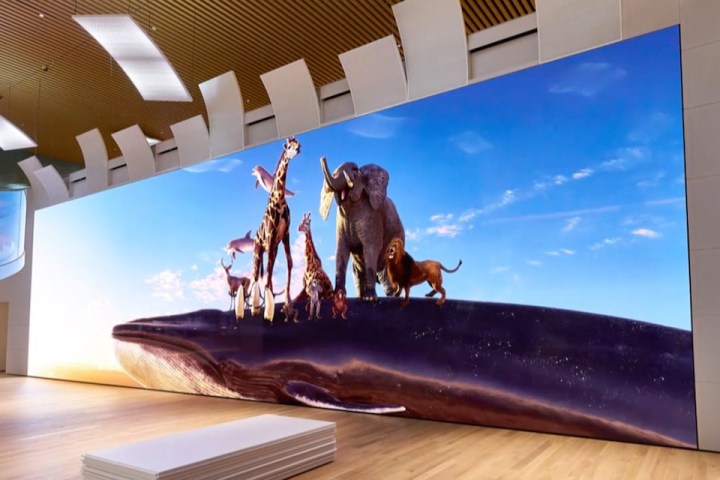
One of the most impressive presentations at CES 2019 was Samsung’s mind-boggling, eye-popping, and straight-up monstrous 4K MicroLED display, known as The Wall. This 219-inch goliath comprises multiple panels pressed together, with each one bearing nascent MicroLED display technology. It uses tiny LEDs that are self-emissive — meaning each pixel lights up independently without the need for a backlight — for contrast to rival even OLED screens, as well as improved brightness levels.
Not to be outdone, Sony has created a new MicroLED display that should blow The Wall — and every similar display we know about — out of the water. Packing 16K resolution and standing 17 feet tall by 63 feet wide (or as the BBC puts it, longer than a bus), this is, theoretically, the screen to end all screens, the display of the moment, and the craziest thing we’ve reported on yet in TV land. Announced by Sony at this year’s National Association of Broadcasters (NAB) trade show in Las Vegas, the display is set to debut in Japan, not for screening movies, but as part of a research center for a cosmetics group.
To put things in context, apart from its sheer size, the display’s 16K resolution is light-years ahead of where we are when it comes to consumer TV technology. By the numbers, 16K offers 16 times as many pixels as a 4K display, or 15360×8640 pixel density. While Samsung’s new 8K TVs are actually making their way to market this year (with pricing recently announced), we’re a long way from the adoption of even 4K as the standard technology in most homes, let alone 8K or 16K, mainly due to the fact that the content is still catching up with the tech.
“We’re moving slowly toward 8K TVs at the end of the decade, and who knows how long it will take to get beyond that, so 16K is likely to be limited to the corporate world for the time being,” said David Mercer of Strategy Analytics at the show, as reported by the BBC.
“When you get to this resolution, it delivers almost a quasi-virtual reality experience as your eyes perceive there to be depth to the content,” he added.
We can attest to that from just our 8K experience. While the talk of CES last year was mostly centered around LG’s rollable OLED, it was the company’s window-clear 88-inch 8K OLED TV that blew our minds, offering via its limited reel of 8K footage what was easily the most beautiful picture when it comes to contrast, clarity, and sheer realism this journalist has ever seen.
With a 16K display this massive, it’s difficult to imagine how impressive and immersive the images will be, though a large part of that will depend on the content. For now, according to the report, Sony has produced its own 16K content for its new display using a method it calls “demosaicing” to create “quad ultra-high definition” footage.
Apart from the content concerns, another limitation to Sony’s new 16K marvel (and screens like it) is likely to be the modular design. Even on Samsung’s latest version of The Wall, when you get up close and personal, there are noticeable seams where the multiple panels meet, primarily evident when you move off axis. Still, in a screen as large as Sony’s, the issues should be negligible, and the bezel-less modules appear to reveal a seamless screen from Sony’s image.
Frankly, we’re not sure which aspect of Sony’s new display is most impressive. Whether it’s the ridiculous resolution, the monstrous size, the 16K content created in-house, or the advancements it poses for the MicroLED technology — which Sony calls “Crystal LED” — the presentation appears to be a major step forward for displays in general.
While we may not see the repercussions for years in our living rooms, it’s always fun to know what’s coming down the pike. For now, we’re left to wonder just how we’re going to actually get our eyes on this thing.
Editors' Recommendations
- TCL’s bonkers China-only microLED TV is as tall as Darth Vader
- Samsung reveals 76-inch MicroLED, adds TikTok to all of its 2021 TVs
- The Wall, Samsung’s epic microLED display, just got 300 inches bigger
- Samsung’s new 110-inch MicroLED TV is a wall-gobbling monster
- Sony’s insane 16-foot Crystal LED screens will cost more than a Ferrari

